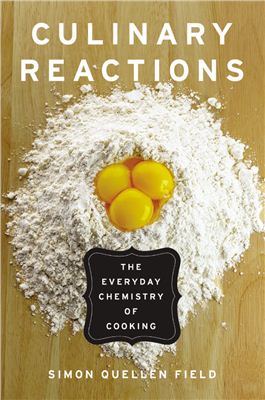The Everyday Chemistry of Cooking. Chicago review Press. 2012. 258
p.
When you’re cooking, you’re a chemist! Every time you follow or modify a recipe you are experimenting with acids and bases, emulsions and suspensions, gels and foams. In your kitchen you denature proteins, crystallize compounds, react enzymes with substrates, and nurture desired microbial life while suppressing harmful microbes. And unlike in a laboratory, you can eat your experiments to verify your hypotheses.
In Culinary Reactions, author Simon Field explores the chemistry behind the recipes you follow every day. How does altering the ratio of flour, sugar, yeast, salt, butter, and water affect how high bread rises? Why is whipped cream made with nitrous oxide rather than the more common carbon dioxide? And why does Hollandaise sauce fall for clarified butter? This easy-to-follow primer even includes recipes to demonstrate the concepts being discussed, including Whipped Creamsicle Topping (a foam), Cherry Dream Cheese (a protein gel), and Lemonade with Chameleon Eggs (an acid indicator). It even shows you how to extract DNA from a Halloween pumpkin. You’ll never look at your graduated cylinders, Bunsen buers, and beakers . . . er, measuring cups, stovetop buers, and mixing bowls . . . the same way again.
Contents
Introduction
Measuring and Weighings
Foams
Emulsions
Colloids, Gels, and Suspensions
Oils and Fats
Solutions
Crystallization
Protein Chemistry
Biology
Scaling Recipes Up and Down
Heating
Acids and Bases
Oxidation and Reduction
Boiling, Freezing, and Pressure
Index
When you’re cooking, you’re a chemist! Every time you follow or modify a recipe you are experimenting with acids and bases, emulsions and suspensions, gels and foams. In your kitchen you denature proteins, crystallize compounds, react enzymes with substrates, and nurture desired microbial life while suppressing harmful microbes. And unlike in a laboratory, you can eat your experiments to verify your hypotheses.
In Culinary Reactions, author Simon Field explores the chemistry behind the recipes you follow every day. How does altering the ratio of flour, sugar, yeast, salt, butter, and water affect how high bread rises? Why is whipped cream made with nitrous oxide rather than the more common carbon dioxide? And why does Hollandaise sauce fall for clarified butter? This easy-to-follow primer even includes recipes to demonstrate the concepts being discussed, including Whipped Creamsicle Topping (a foam), Cherry Dream Cheese (a protein gel), and Lemonade with Chameleon Eggs (an acid indicator). It even shows you how to extract DNA from a Halloween pumpkin. You’ll never look at your graduated cylinders, Bunsen buers, and beakers . . . er, measuring cups, stovetop buers, and mixing bowls . . . the same way again.
Contents
Introduction
Measuring and Weighings
Foams
Emulsions
Colloids, Gels, and Suspensions
Oils and Fats
Solutions
Crystallization
Protein Chemistry
Biology
Scaling Recipes Up and Down
Heating
Acids and Bases
Oxidation and Reduction
Boiling, Freezing, and Pressure
Index

